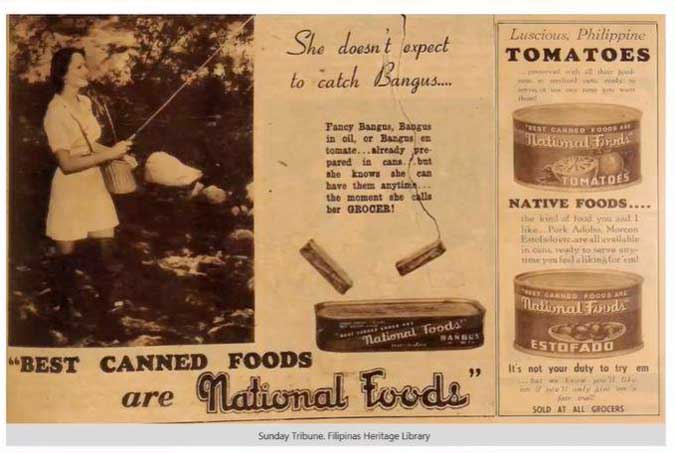FILIPINOS of a certain age remember that as picky children they often received a dismissive sniff from older relatives: “Hindi ka mabubuhay sa guerra (You can’t survive a war).” It’s easy to think of this pandemic as a war, and it is also a period of struggle and hardship. Perhaps we can learn a little from our ancestors on how to survive national trauma.
The importance of food during one of the nation’s most traumatic events — the Japanese Occupation of the Second World War — was the focus of a talk called “Dreams of Cake and Ice Cream: Coping with Hunger in World War II,” held on Nov. 7. The talk was given by the Filipinas Heritage Library in partnership with the Ayala Foundation, the US Embassy, and Manila Bulletin via Zoom and Facebook Live. It was the second of a webinar series forming part of the Liberation: War and Hope series of events commemorating the 75th anniversary of the end of World War II.
Food historian and author Felice Prudente Sta. Maria opened the talk by introducing her wartime relatives, the Yulos (a last name that firmly sits in Manila’s society lists). The Yulos served as characters in her talk, as a way of highlighting the prosperity of the Commonwealth period. “Each person had a personal comfort zone,” Ms. Sta. Maria said, emphasizing however that the coming war — thanks to conflicts in faraway Europe, and closer to home, Japanese imperial ambitions for Asia — gave the country’s leaders a reality check. “In the 1930s, the challenge was the fear of another war,” she said.
Those thoughts could be delayed a few more years or so, since Ms. Sta. Maria said, the 1930s were a “golden age for home and the kitchen.” This was thanks to the arrival of American home appliances, but more importantly, widespread education that brought Home Economics subjects to school textbooks around the country beginning in 1904. “Cooking and eating were means of uniting a family,” she said.
“Food security became everyone’s responsibility,” said Ms. Sta. Maria.
She discussed the creation of the National Economic Protectionism Association (surviving today as NEPA Q-Mart in Cubao, Quezon City), which advocated for local products to prevent the exit of precious foreign money reserves, and increase domestic productivity and spending. At the time, the Philippines was spending millions on imported food such as wheat, and also on canned goods such as salmon, green beans, and asparagus. In response, the NEPA tapped scientists like Maria Orosa (hailed now as a hero, and famous for her invention, banana ketchup) to develop recipes for local produce, and also to provide ways to utilize produce for optimal nutrition (an example would be cookies made with rice bran). Ms. Orosa did them one better and invented an oven fit to be used in rural homes: the palayok (clay pot) oven with racks that could be burned over coal stoves (though wealthy Manileños already enjoyed conveniences such as electric stoves).
Meanwhile, to defeat the damaging dependence on imported canned food, a company called National Foods made canned Filipino dishes. At first it wasn’t that good, and this prompted the company to tweak its recipes to please some of the highest tables in the land such as that of Commonwealth leader Manuel L. Quezon. The local canned food served two purposes: to feed families conveniently, and also to feed the army.
The Philippines was attacked by the Japanese just a few hours after the Dec. 8, 1941 attack on Pearl Harbor. Manila was declared an Open City to prevent bloodshed, but this date also marked the beginning of a food crisis which ended only after the end of the War.
Manila citizens piled on their supplies: lots of canned goods. They ranged from canned beans, coffee, tea, sugar, milk, fish, and soup; augmented by supplies of native tapa (preserved meat) and tuyo (dried and salted fish). Gardens, both public and private, were converted into vegetable plots to feed the cities. The provinces had it relatively easy: since they grew their own food, they were able to feed themselves quite well — and also gained money from it: some stories had glamorous Manileños exchanging their fine goods for food.
Ms. Sta. Maria related how her family, the Yulos, were forced to hide due to their aid to the Underground. In a fishpond in Bulacan, a Yulo sister stockpiled rice and mung beans (monggo, a high-protein source in the absence of meat and fish). That ancestor made sure to use rice wash in her soup for added nutrition. Soup was an important food since it could be stretched to feed many. Ms. Sta. Maria said that some housewives took a bit of tuyo and dipped that into the soup — just to flavor it — then would take it out again to save it for another day. Vegetable peelings were washed, saved, and cooked along with the soup. A decline in commodities forced people to find substitutes: roast corn kernels for coffee, and mature coconuts for chestnuts (though this was a pre-war delicacy). “Nothing was wasted. Food was so precious,” she said.
Ms. Sta. Maria quoted her now-neighbor, a teenager who kept a wartime diary, Fely Zafra. “When I think of strawberry shortcake, chicken, ham, relleno, and ice water, my heart aches and a drowsy numbness sets in.” This was a far cry from her family’s pre-war treats, and a sad note on how much we end up missing the things we take for granted. — J.L. Garcia



